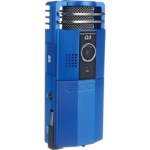
January 03, 2010
Providing exceptional portable recording solutions
for people who care about sound.
Happy New Year!
We wish you a safe, healthy and abundant 2010.
| Subscribe | RSS Feed |
In today's issue:
Your Questions Answered: Mono or Stereo?
Featured Item: Zoom Q3 Handy Recorder
Your Questions Answered: Mono or Stereo?
In this section, we share an answer to one of your questions.
Q: If I'm recording voice for podcast, or an interview with me and another person, should I record it in mono or stereo?
A: Mono is best for spoken voice. Stereo is best for music. Most spoken voice podcasts are encoded in mono and most spoken voice radio shows are broadcast in mono. Spoken voice is rarely recorded in stereo because the sound emanates from a single point and it is more difficult for one person to effectively handle two microphones at the same time.
Also, recording spoken voice in stereo can cause a distracting shift in sound from side to side, especially for listeners who use headphones. This is one area where the stereo effect is not necessarily desirable.
More benefits of mono. A mono audio file is half the size of a stereo file and is therefore much easier to stream and download. Mono files always have higher fidelity at a given bit rate because only a single channel is encoded instead of two. Likewise, mono radio signals require less power to broadcast than stereo signals and are easier to tune in even if the signals aren't very clear or strong.
Of course, the decision is yours as to which sounds best. But as a rule of thumb, record spoken voice in mono and record music in stereo to capture its spaciousness and wider dynamic and frequency ranges.
The only handheld recorders that encode in true, single channel mono are the Marantz PMD661, the Marantz PMD620, and the Olympus LS-11.
The Zoom and Tascam recorders have a "mono mix" feature that creates a stereo file where the left and right channels have the same content. The Edirol R-09HR encodes in mono only with an external microphone.
Although recording direct to mono will save you a lot of time and storage space, do not despair if you do not have one of the recorders mentioned above. Most stereo files can be converted to mono with audio editing software like Audacity.
Featured Item: Zoom Q3 Handy Recorder
 The Zoom Q3 is a fun, easy to use, and powerful tool for musicians of all levels. Imagine recording a video with high quality audio and in just a few steps uploading it to YouTube or transferring it to your student's iPod or USB key. As the saying goes, "a picture is worth a thousand words," especially if it is a moving picture with great sound! We strongly recommend using the Zoom Q3 with the optional AD-14 ac adapter and shell QCase. The Zoom Q3 is in stock and on sale now for $249.00.
The Zoom Q3 is a fun, easy to use, and powerful tool for musicians of all levels. Imagine recording a video with high quality audio and in just a few steps uploading it to YouTube or transferring it to your student's iPod or USB key. As the saying goes, "a picture is worth a thousand words," especially if it is a moving picture with great sound! We strongly recommend using the Zoom Q3 with the optional AD-14 ac adapter and shell QCase. The Zoom Q3 is in stock and on sale now for $249.00.